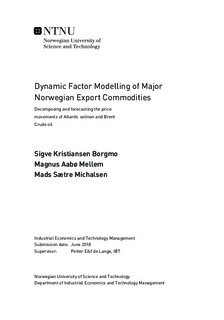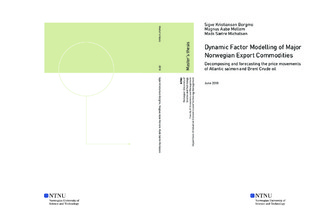| dc.description.abstract | This thesis studies the price movements of two major Norwegian export commodities, Atlantic salmon and Brent Crude oil, using a dynamic factor modelling approach. We pursue two different avenues of research, namely co-movement and composition analysis of commodity price returns and forecasting of future spot prices.
In the first study, we investigate dynamic co-movement in global commodity markets via a restricted dynamic factor model (DFM) and decompose commodity returns into global, sectoral, and idiosyncratic components. This decomposition allows us to estimate the degree to which global, sectoral and commodity-specific factors explain the fluctuations in individual commodity prices. We find that our DFM constitutes a crude, but effective, tool for analyzing commodity price movements. Studying Atlantic salmon and Brent Crude, we find that a moderate, but significant, fraction of their price movements over the sample period (1980-2018) can be attributed to shocks to a global factor representing common, demand-driven trends in global commodity markets. Notably, a sub-sample analysis reveals that since 2000, the global factor's importance has increased significantly for both commodities, indicating an increased level of integration with global commodity markets.
In the second study, we use the DFM framework to forecast the prices of Atlantic salmon and Brent Crude oil. Specifically, the monthly spot price is predicted 1-3 months ahead using data from 2006 to 2018. We assemble a comprehensive set of predictors for each commodity, and carry out model selection by employing a genetic algorithm. The resulting models' out-of-sample performances are assessed and compared against more commonly used forecasting models and results from the literature.
We find that our forecasts improve upon all benchmarks across all horizons for both commodities.
Our results indicate that there is value to be gained from forecasting based on latent, estimated factors representing co-variation within a set of recognized predictor variables, rather than based on the predictor variables directly. | |

